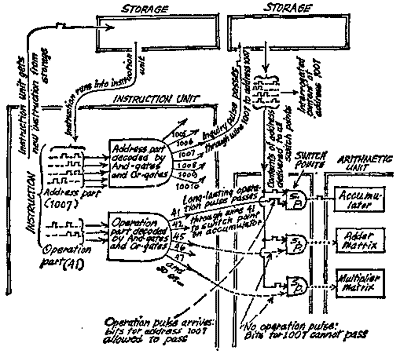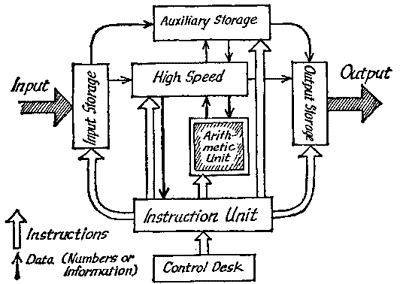Instruction Unit
Now we must introduce a very important part of our computer, and one we have not mentioned before: the control and instruction unit. This has to ensure that our computer is in a fit state to do any work at all. It calls out the instructions to the storages and sees that they are carried out. It is, so to speak, the brain of the electronic brain. The instruction unit alone makes the computer a robot, an automaton, a thing capable of doing something all on its own.
But there is still something that we must do first: we have to start up the instruction unit.
May we ask you to come a little closer to the control desk of our computer? It is the "ER 56" again that we are taking as an example. You will notice a group of buttons with numbers on them, an assemblage of keys, a row of lights, chains of little signal lamps ...
No, we do not want to explain all that in detail. We would merely like to ask you to press down the numbered button in accordance with the number of the address containing the first instruction of our program. It is 3000.
Have you done so? Good. The machine still gives no sign of life. But if you now just depress the button with START on it ...
You will not be able to see what happens at this moment. The current flowing through wires, transistors and magnetic cores is invisible. Even if you could, you wouldn't be able to recognize it: it moves too fast.
Still, we would like to try to explain to you what takes place. Pressing down the START key opens up the way for the instruction from address 3000 into the instruction unit. While it is still en route, the instruction unit has noted the address number 3000 in a special storage, added a 1 to it and stored the new number - 3001. It knows that this is the address from which it must get the next instruction.
Meanwhile the instruction from address 3000 has entered the instruction unit and introduces itself.
This sequence of numbers is naturally expressed in bits, in "1"s and "0"s, and the bits of the first four digits start work at once. They send an inquiry pulse (as we saw in the last chapter) to address 1007. (For simplicity's sake we shall pay no attention to the index number 3. We are concerned for the moment with our friend Duncan MacKenzie, for whom there is nothing but a zero in the index.) The technical proceedings, as a result of which the bit for the number 1007 turns into a single pulse of current which hastens to address 1007 in the form of an inquiry pulse, will become clear to you if you recall our remarks in chapter 4. And-gates and or-gates sort out the pulses ("decode" them) until only one of them is left - in the wire leading direct to address 1007.
While the address part is making inquiries about the contents of the address, the operation part is not wasting its time either. It has decoded itself likewise, and as a single pulse - but as a particularly long-lasting one - it is led on to a wire numbered "41." From there it plays the part of a railway signalman and takes care to see that the content of address 1007 is switched into the accumulator. (This applies of course only to the "41." If the operation number is "45," for example, the contents of the address must be led into the adder matrix.)
These electric switches are nothing but our old friends, the and-gates. They are located in front of all the units of the computer, blocking access to them. The pulses leaving address 1007, eagerly on their way, are in for a disappointment. The way to the adder matrix, the multiplier matrix, to the other storages, is barricaded everywhere by closed and-gates. But the pulse of operation number 41 comes to their rescue. Its wire leads to the and-gates keeping watch at the entrance to the accumulator. Lo! The "41" pulse and the pulses from address 1007, keeping each other company, are irresistible. The and-gate responds and opens, the pulses pass and flow into the accumulator. (The operation pulse, as we have already indicated, is a particularly long one, so that all the pulses from address 1007 can get through and arrive unharmed.)
Is that very complicated? Perhaps Illus. 38 will make the co-operation of instruction unit and switch-points clearer:

You will be able to imagine how the process continues. As soon as a counting operation is completed (for example, as soon as the last figure of a number has been added) information is given by a reporting pulse to the instruction unit from the computer department concerned: "Instruction carried out" The instruction unit then gets the next instruction from the storage. The instruction unit knows where this is, for it has of course noted the address. While the new instruction is on its way in, the instruction unit is already making a note of the address of the next instruction ... but that is no longer news to you.
We can now elaborate our drawing of the block diagram for the computer, an outline of which we started in this Illustration, by adding the instruction unit and the control desk and showing how the instructions run and how the flow of numbers moves for the calculation process:

All electronic computers, everywhere, operate on the principle of this block diagram. You have now made the acquaintance of every important unit in electronic data processing machines. There is only one apparatus you have not yet been properly introduced to: the man who sits in front of the machine and tells it what it has to do and how the job must be dome - the man who draws up the program.
We shall deal with him in the next chapter.
©
by PhiloPhax & Lauftext
& Redaktion Lohberg
Kybernetik
- Was ist das?
First printed in Germany: 1963